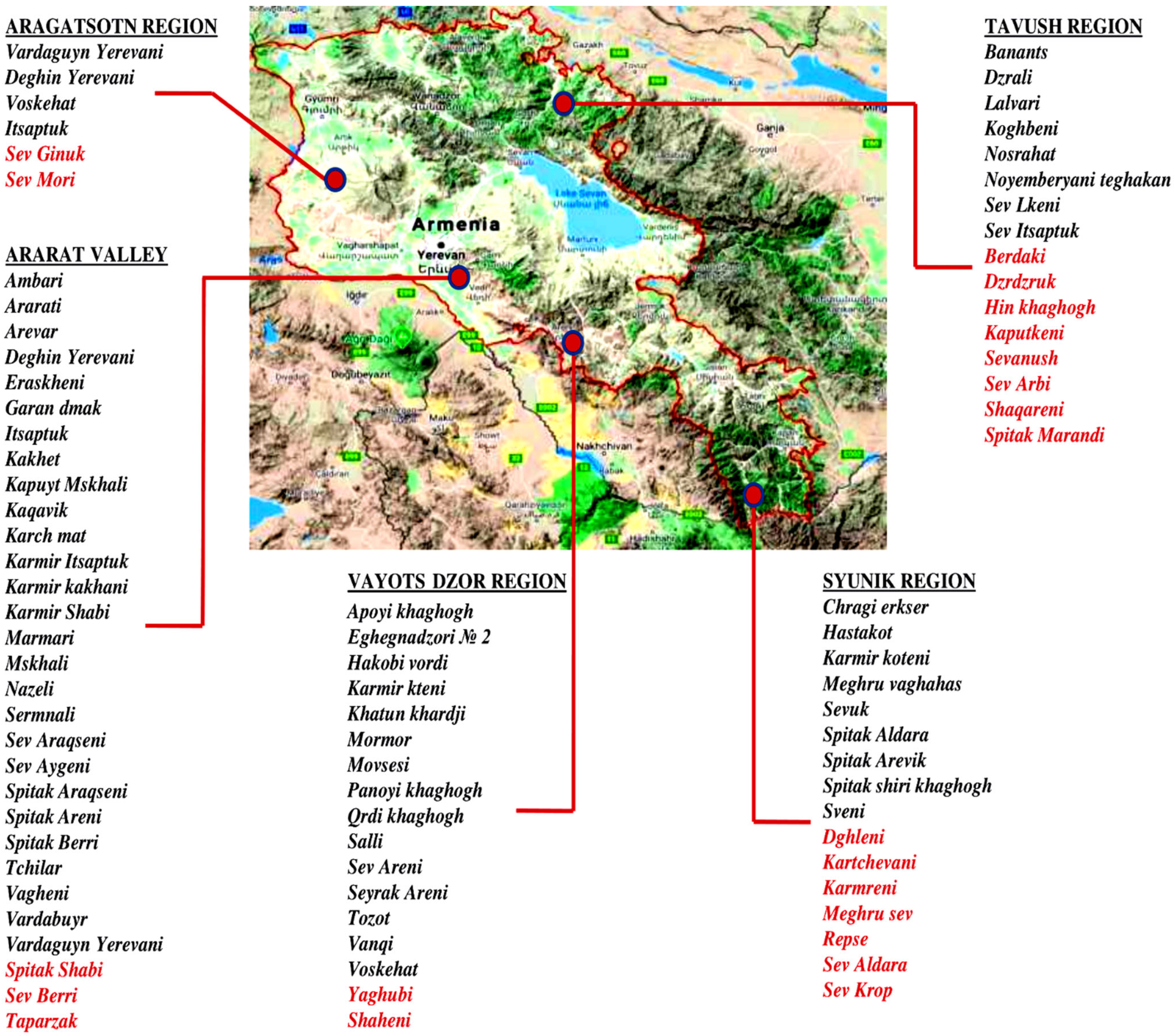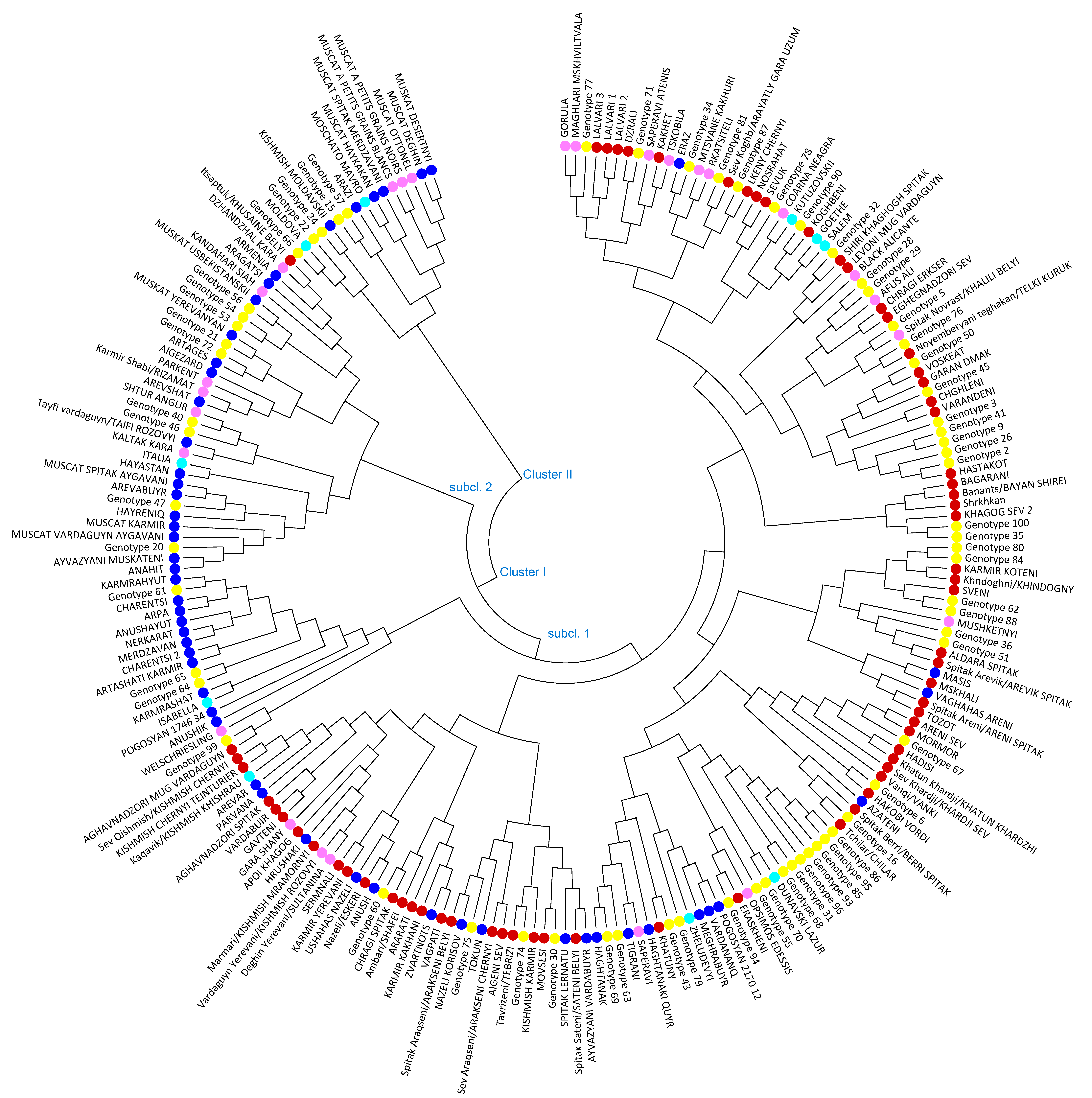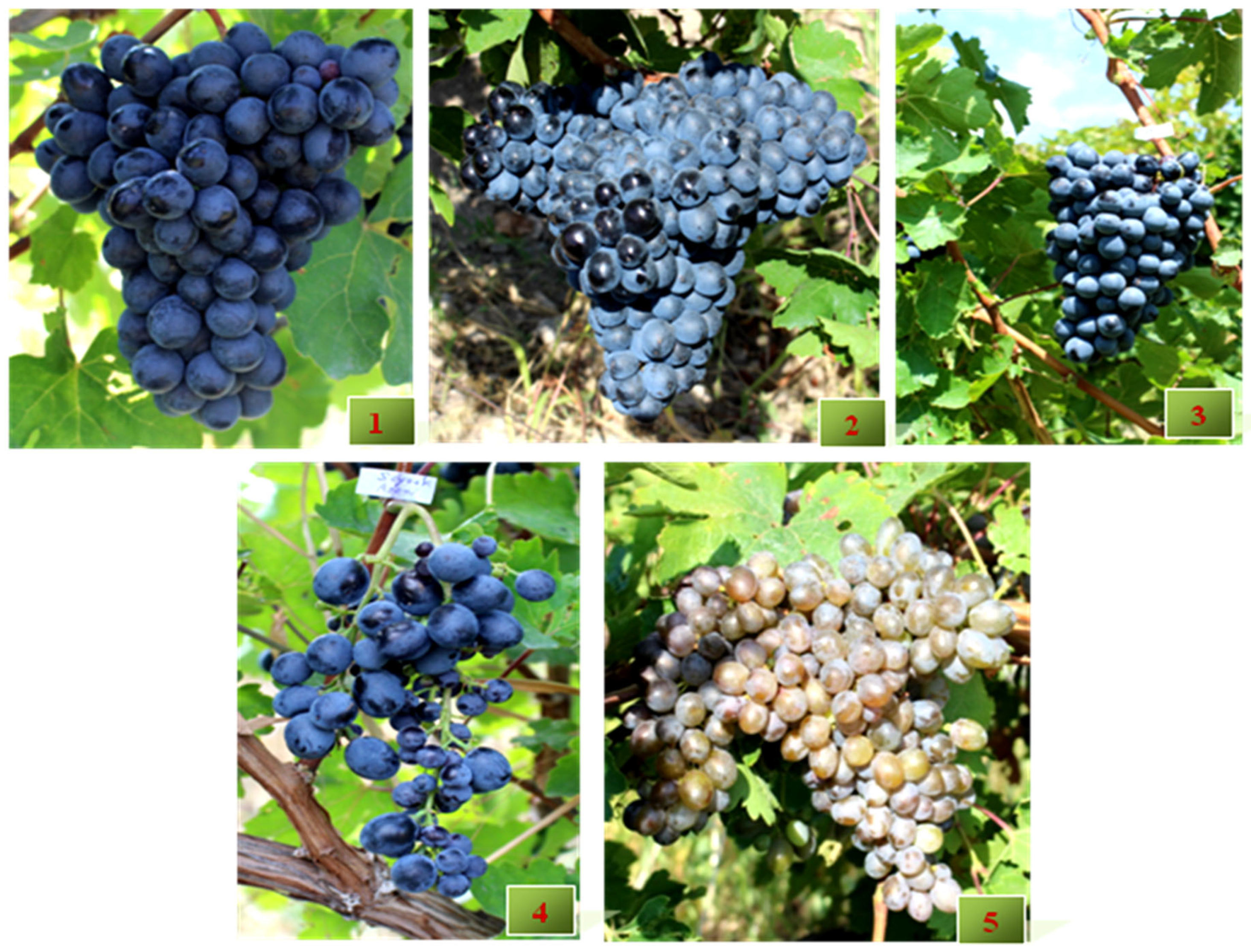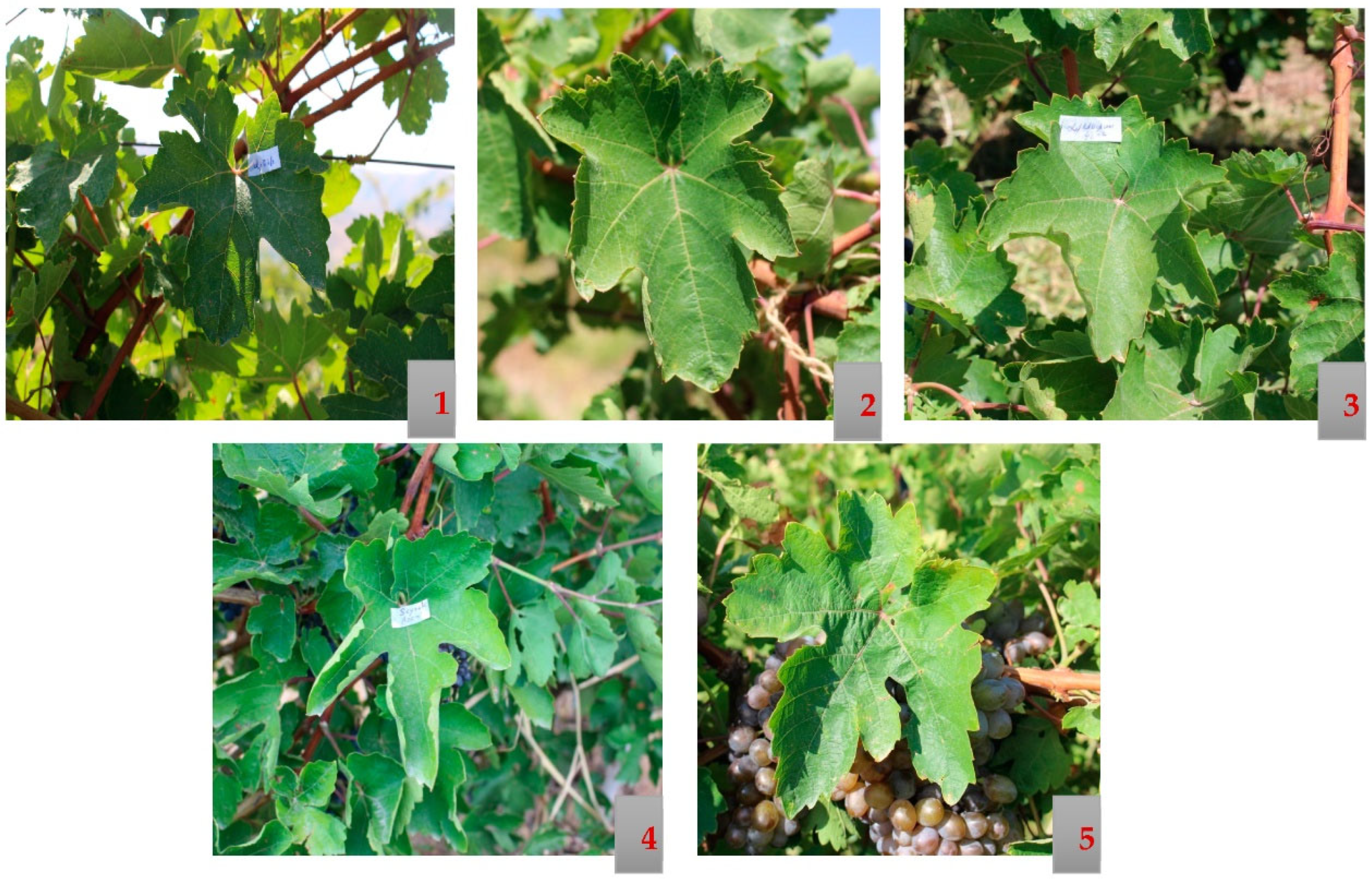Genetic Diversity of Armenian Grapevine (Vitis vinifera L.) Germplasm: Molecular Characterization and Parentage Analysis
Abstract
:Simple Summary
Abstract
1. Introduction
2. Material and Methods
2.1. Plant Material
2.2. DNA Extraction and nSSR Analysis
2.3. Flower Phenotype Analysis
2.4. Genetic Diversity Analysis
2.5. Parentage Analysis
3. Results
3.1. Identification of Prospected Material
3.2. Flower Phenotype
3.3. Assessment of Genetic Diversity and Relationships of Armenian Grape Germplasm by Microsatellite Analysis
3.4. Parentage Analysis
4. Discussion
4.1. Recent History
4.2. Genetic Diversity and Relatedness in the Armenian Germplasm
5. Conclusions
Supplementary Materials
Author Contributions
Funding
Institutional Review Board Statement
Informed Consent Statement
Data Availability Statement
Acknowledgments
Conflicts of Interest
References
- This, P.; Lacombe, T.; Thomas, M.R. Historical origins and genetic diversity of wine grapes. Trends Genet. 2006, 22, 511–519. [Google Scholar] [CrossRef]
- Levadoux, L. Les populations sauvages et cultivées de Vitis vinifera L. Annl. Amellior Plantes 1956, 6, 59–118. [Google Scholar]
- Alleweldt, G. Genetics of Grapevine Breeding. In Progress in Botany; Behnke, H.D., Lüttge, U., Esser, K., Kadereit, J.W., Runge, M., Eds.; Springer: Berlin/Heidelberg, Germany, 1997; Volume 58, pp. 441–454. [Google Scholar]
- Myles, S.; Boyko, A.R.; Owens, C.L.; Brown, P.J.; Grassi, F. Genetic structure and domestication history of the grape. Proc. Natl. Acad. Sci. USA 2011, 108, 3530–3535. [Google Scholar] [CrossRef] [PubMed] [Green Version]
- Negrul, A.M. Evoluciya kulturnyx form vinograda. Dokl. Akad. Nauk. SSSR 1938, 8, 585–588. [Google Scholar]
- Adler, D.; Tushabramishvili, N. Middle Palaeolithic patterns of settlement and subsistence in the southern Caucasus. In Middle Palaeolithic Settlement Dynamics; Conard, N.J., Ed.; Kerns Verlag: Tübingen, Germany, 2004; Volume 2, pp. 91–132. [Google Scholar]
- Miller, N.F. Sweeter than wine? The use of the grape in early western Asia. Antiquity 2008, 82, 937–946. [Google Scholar] [CrossRef]
- Terral, J.F. Quantitative anatomical criteria for discriminating wild grapevine (Vitis vinifera ssp. sylvestris) from cultivated vines (Vitis vinifera ssp. vinifera). Br. Archaeol. Rep. Int. Ser. 2002, 1063, 59–64. [Google Scholar]
- Labra, M.; Failla, O.; Forni, G.; Ghiani, A.; Scienza, A.; Sala, F. Microsatellite Analysis to define genetic diversity of grapevines (Vitis vinifera L.) grown in Central and Western Mediterranean Countries. J. Int. Sci. Vigne Vin. 2002, 36, 11–20. [Google Scholar] [CrossRef]
- McGovern, P.E. Ancient Wine: The Search for the Origins of Viniculture; Princeton University Press: Princeton, NJ, USA, 2003. [Google Scholar]
- Zohary, D.; Hopf, M.; Weiss, E. Domestication of Plants in the Old World. In The Origin and Spread of Domesticated Plants in South-West Asia, Europe and the Mediterranean Basin, 4th ed.; Oxford University Press: Oxford, UK, 2012. [Google Scholar]
- Olmo, H.P. The origin and domestication of vinifera grape. In The Origin and Ancient History of Wine; McGovern, P., Fleming, S.J., Katz, S.H., Eds.; Taylor & Francis: Amsterdam, The Netherlands, 2005; pp. 53–67. [Google Scholar]
- McGovern, P.; Jalabadze, M.; Batiuk, S.; Callahan, M.P.; Smith, K.E.; Hall, G.R.; Kvavadze, E.; Maghradze, D.; Rusishvili, N.; Bouby, L.; et al. Early Neolithic wine of Georgia in the South Caucasus. Proc. Natl. Acad. Sci. USA 2017, 114, E10309–E10318. [Google Scholar] [CrossRef] [PubMed] [Green Version]
- Laucou, V.; Launay, A.; Bacilieri, R.; Lacombe, T.; Adam-Blondon, A.F.; Bérard, A.; Chauveau, A.; de Andrés, M.T.; Hausmann, L.; Ibáñez, J.; et al. Extended diversity analysis of cultivated grapevine Vitis vinifera with 10 K genome-wide SNPs. PLoS ONE 2018, 13, e0192540. [Google Scholar] [CrossRef] [PubMed]
- Nikoghosyan, M.; Schmidt, M.; Margaryan, K.; Loeffl-Wirth, H.; Arakelyan, A.; Binder, H. SOMmelier—Intuitive Visualization of the Topology of Grapevine Genome Landscapes Using Artificial Neural Networks. Genes 2020, 11, 817. [Google Scholar] [CrossRef] [PubMed]
- Margaryan, K.; Maul, E.; Muradyan, Z.; Hovhannisyan, A.; Melyan, G.; Aroutiounian, R. Evaluation of breeding potential of wild grape originating from Armenia. BIO Web Conf. 2019, 15, 01006. [Google Scholar] [CrossRef]
- Barnard, H.; Dooley, A.; Areshian, G.; Gasparian, B.; Faull, K.F. Chemical evidence for wine production around 4000 BCE in the Late Chalcolithic Near Eastern highlands. J. Archaeol. Sci. 2011, 38, 977–984. [Google Scholar] [CrossRef]
- Harutyunyan, A.F. Viticulture and Wine-Making in Armenia (Vinogradarstvo I Vinodelie v Armenii) Copyright Edition; Deutsche Gesellschaft für Internationale Zusammenarbeit (GIZ): Yerevan, Armenia, 2007; p. 704. (In Russian) [Google Scholar]
- Poghosyan, S.H. Haykakan Sovetakan Sotsialistakan Respublikai Ampelografiya II (Ampelography of the Armenian Soviet Socialist Republic II); Haykakan Petakan Gyughatntesakan Hrataraktchutyun: Yerevan, Armenia, 1962; p. 742. (In Armenian) [Google Scholar]
- Dilanyan, T.A. Khaghoghagotsutyuny ev ptghagotsutyuny nakhasovetakan Hayastanum. Banber Hay. Arkhivneri 1970, 2, 173–180. (In Armenian) [Google Scholar]
- Melyan, G.; Gasparyan, S. Viticulture and Winemaking in Armenia. Vitis 2012, 51, 39–84. [Google Scholar]
- Wan, Y.; Schwaninger, H.; Dan, L.; Simon, C.J.; Wang, Y.; Puchau, H. The eco-geographic distribuition of wild grape germpasm in China. Vitis 2008, 47, 77–80. [Google Scholar]
- OIV Descriptor List for Grape Varieties and Vitis Species, 2nd ed.; Organisation Internationale de la Vigne et du Vin: Paris, France, 2009; p. 75008.
- Crespan, M.; Migliaro, D.; Larger, S.; Pindo, M.; Palmisano, M.; Manni, A.; Manni, E.; Polidori, E.; Sbaffi, F.; Silvestri, Q.; et al. Grapevine (Vitis vinifera L.) varietal assortment and evolution in the Marche region (central Italy). OENO One 2021, 3, 17–37. [Google Scholar] [CrossRef]
- De Lorenzis, G.; Mercati, F.; Bergamini, C.; Cardone, M.F.; Lupini, A.; Mauceri, A.; Caputo, A.R.; Abbate, L.; Barbagallo, M.G.; Antonacci, D.; et al. SNP genotyping elucidates the genetic diversity of Magna graecia grapevine germplasm and its historical origin and dissemination. BMC Plant Biol. 2019, 19, 1–15. [Google Scholar] [CrossRef]
- D’Onofrio, C. Introgression among cultivated and wild grapevine in Tuscany. Front. Plant Sci. 2020, 11, 14. [Google Scholar] [CrossRef]
- Maras, V.; Tello, J.; Gazivoda, A.; Mugosa, M.; Perisic, M.; Raicevic, J.; Stajner, N.; Ocete, R.; Bozovic, V.; Popovic, T.; et al. Population genetic analysis in old Montenegrin vineyards reveals ancient ways currently active to generate diversity in Vitis Vinifera. Sci. Rep. 2020, 10, 13. [Google Scholar] [CrossRef] [PubMed]
- De Oliveira, G.L.; de Souza, A.P.; de Oliveira, F.A.; Zucchi, M.I.; de Souza, L.M.; Moura, M.F. Genetic structure and molecular diversity of Brazilian grapevine germplasm: Management and use in breeding programs. PLoS ONE 2020, 15, 26. [Google Scholar] [CrossRef]
- Mihaljevic, M.Z.; Maletic, E.; Preiner, D.; Zdunic, G.; Bubola, M.; Zyprian, E.; Pejic, I. Genetic diversity, population structure, and parentage analysis of Croatian grapevine germplasm. Genes 2020, 11, 30. [Google Scholar]
- Raimondi, S.; Tumino, G.; Ruffa, P.; Boccacci1, P.; Gambino, G.; Schneider, A. DNA-based genealogy reconstruction of Nebbiolo, Barbera and other ancient grapevine cultivars from northwestern Italy. Sci. Rep. 2020, 10, 15782. [Google Scholar] [CrossRef]
- Margaryan, K.; Maul, E.; Muradyan, Z.; Hovhannisyan, A.; Devejyan, H.; Melyan, G.; Aroutiounian, R. Armenian National Grapevine Collection: Conservation, Characterization and Prospects. BIO Web Conf. 2019, 12, 5. [Google Scholar] [CrossRef]
- Laucou, V.; Lacombe, T.; Dechesne, F.; Siret, R.; Bruno, J.B.; Dessup, M.; Dessup, T.; Ortigosa, P.; Parra, P.; Roux, C.; et al. High throughput analysis of grape genetic diversity as a tool for germplasm collection management. Theor. Appl. Genet. 2011, 122, 1233–1245. [Google Scholar] [CrossRef]
- Sefc, K.M.; Regner, F.; Turetschek, E.; Glössl, J.; Steinkellner, H. Identification of microsatellite sequences in Vitis riparia and their applicability for genotyping of different Vitis species. Genome 1999, 42, 367–373. [Google Scholar] [CrossRef] [PubMed]
- Maul, E.; Sudharma, K.N.; Kecke, S.; Marx, G.; Müller, C.; Audeguin, L.; Boselli, M.; Boursiquot, J.M.; Bucchetti, B.; Cabello, F.; et al. The European Vitis Database (www.eu-vitis.de)–a technical innovation through an online uploading and interactive modification system. Vitis 2012, 51, 79–86.Ta. [Google Scholar]
- Bacilieri, R.; This, P. GrapeGen06, an European Project for the Management and Conservation of Grapevine Genetic Resources. 2010. Available online: http://www1.montpellier.inra.fr/grapegen06/ (accessed on 15 August 2021).
- Maul, E.; Töpfer, R.; Carka, F.; Cornea, V.; Crespan, M.; Dallakyan, M.; de Andrés Domínguez, T.; de Lorenzis, G.; Dejeu, L.; Goryslavets, S.; et al. Identification and characterization of grapevine genetic resources maintained in Eastern European Collections. Vitis 2015, 54, 5–12. [Google Scholar]
- Fechter, I.; Hausmann, L.; Daum, M.; Sörensen, T.R.; Viehöver, P.; Weisshaar, B.; Töpfer, R. Candidate genes within a 143 kb region of the flower sex locus in Vitis. Mol. Genet. Genom. 2012, 287, 247–259. [Google Scholar] [CrossRef] [PubMed]
- Nei, M. Analysis of gene diversity in subdivided populations. Proc. Natl. Acad. Sci. USA 1973, 70, 3321–3323. [Google Scholar] [CrossRef] [PubMed] [Green Version]
- Peakall, R.; Smouse, P.E. GenAlex 6: Genetic analysis in Excel. Population genetic software for teaching and research. Mol. Ecol. Notes 2006, 6, 288–295. [Google Scholar] [CrossRef]
- Kumar, S.; Stecher, G.; Tamura, K. MEGA7: Molecular Evolutionary Genetics Analysis Version 7.0 for Bigger Datasets. Mol. Biol. Evol. 2016, 33, 1870–1874. [Google Scholar] [CrossRef] [PubMed] [Green Version]
- Saitou, N.; Nei, M. The neighbor-joining method: A new method for reconstructing phylogenetic trees. Mol. Biol. Evol. 1987, 4, 406–425. [Google Scholar] [PubMed]
- Kalinowski, S.T.; Taper, M.L.; Marshall, T.C. Revising how the computer program CERVUS accommodates genotyping error increases success in paternity assignment. Mol. Ecol. 2007, 16, 1099–1106. [Google Scholar] [CrossRef]
- Jones, O.R.; Wang, J. COLONY: A program for parentage and sibship inference from multilocus genotype data. Mol. Ecol. Resour. 2009, 10, 551–555. [Google Scholar] [CrossRef] [PubMed]
- Tumanyan, M. Haykakan Sovetakan Sotsialistakan Respublikai Ampelografiya I (Ampelography of the Armenian Soviet Socialist Republic I); Armenian SSR Academy of Sciences Press (Haykakan SSR Gitutyunneri Akademiayi Hrataraktchutyun): Yerevan, Armenia, 1947; p. 357. (In Armenian) [Google Scholar]
- Poghosyan, S.H. Haykakan Sovetakan Sotsialistakan Respublikai Ampelografiya III (Ampelography of the Armenian Soviet Socialist Republic III); Hayastan: Yerevan, Armenia, 1981; p. 385. (In Armenian) [Google Scholar]
- Frolov-Bagreev, A.M.; Negrul, A.M.; Blagonravov, P.P. Ampelogafiya SSSR I–VI (Ampelography of SSSR I–VI); Pishchepromizdat: Moskva (Moscow), Russia, 1946–1956. (In Russian) [Google Scholar]
- Kartavchenko, P.K.; Blagonravov, P.P. Ampelogafiya SSSR I–III (Ampelography of SSSR I–III; Pishchepromizdat: Moscow, Russia, 1963–1970. (In Russian) [Google Scholar]
- Golodriga, P.Y.; Panarina, A.M.; Troshin, L.P. Ampelogafiya SSSR (Ampelography of SSSR); Lyoghkaya I Pishchevaya Promishlennost: Moscow, Russia, 1984. (In Russian) [Google Scholar]
- Maghradze, D.; Rustioni, L.; Turok, J.; Scienza, A.; Failla, O. Caucasus and Northern Black Sea Region Ampelography; VITIS: Maierdruck, Germany, 2012. [Google Scholar]
- Melyan, G.; Safaryan, D.; Nersisyan, A. Ampelography, Copyright Edition; Food and Agriculture Organization of the United Nations: Yerevan, Armenia, 2019. [Google Scholar]
- Lacombe, T.; Boursiquot, J.M.; Laucou, V.; Di Vecchi-Staraz, M.; Peros, J.P.; This, P. Large-scale parentage analysis in an extended set of grapevine cultivars (Vitis vinifera L.). Theor. Appl. Genet. 2013, 126, 401–414. [Google Scholar] [CrossRef]
- Cipriani, G.; Spadotto, A.; Jurman, I.; Di Gaspero, G.; Crespan, M.; Meneghetti, S.; Frare, E.; Vignani, R.; Cresti, M.; Morgante, M.; et al. The SSR-based molecular profile of 1005 grapevine (Vitis vinifera L.) accessions uncovers new synonymy and parentages, and reveals a large admixture amongst varieties of different geographic origin. Theor. Appl. Genet. 2010, 121, 1569–1585. [Google Scholar] [CrossRef]
- Aradhya, M.K.; Dang, G.S.; Prins, B.H.; Boursiquot, J.M.; Walker, M.A.; Meredith, C.P.; Simon, C.J. Genetic structure and differentiation in cultivated grape Vitis vinifera L. Genet. Res. 2003, 81, 179–192. [Google Scholar] [CrossRef] [Green Version]
- De Lorenzis, G.; Chipashvili, R.; Failla, O.; Maghradze, D. Study of genetic variability in Vitis vinifera L. germplasm by high-throughput Vitis 18kSNP array: The case of Georgian genetic resources. BMC Plant Biol. 2015, 15, 2–14. [Google Scholar] [CrossRef] [PubMed] [Green Version]
- Bacilieri, R.; Lacombe, T.; Le Cunff, L.; Di Vecchi-Staraz, M.; Laucou, V.; Genna, B.; Peros, J.P.; This, P.; Boursiquot, J.M. Genetic structure in cultivated grapevines is linked to geography and human selection. BMC Plant Biol. 2013, 13, 14. [Google Scholar] [CrossRef] [Green Version]
- Pelsy, F. Molecular and cellular mechanisms of diversity within grapevine varieties. Heredity 2010, 104, 331–340. [Google Scholar] [CrossRef] [PubMed]
- Strioto, D.K.; Pepineli, A.C.; Eisele, T.G.; Marinelli, G.C.; Mangolin, C.A.; Cantagali, L.B.; de Oliveira-Collet, S.A.; de Fátima P.S.Machado, M. Clonal propagation of cv. Italy grapes and the generation of genetic divergence among vineyards. Sci. Hortic. 2019, 244, 263–269. [Google Scholar] [CrossRef]
- Vondras, A.M.; Minio, A.; Blanco-Ulate, B.; Figueroa-Balderas, R.; Penn, M.A.; Zhou, Y.F.; Seymour, D.; Ye, Z.; Liang, D.R.; Espinoza, L.K.; et al. The genomic diversification of grapevine clones. BMC Genom. 2019, 20, 19. [Google Scholar] [CrossRef] [PubMed] [Green Version]
- Crespan, M. Evidence on the evolution of polymorphism of microsatellite markers in varieties of Vitis vinifera L. Theor. Appl. Genet. 2004, 108, 231–237. [Google Scholar] [CrossRef] [PubMed]
- Torregrosa, L.; Fernandez, L.; Bouquet, A.; Boursiquot, J.M.; Pelsy, F.; Martinez-Zapater, J.M. Origins and consequences of somatic variation in grapevine. In Genetics, Genomics and Breeding of Crop Plants; Kole, C., Ed.; Science Publishers: Boca Raton, FL, USA, 2011; pp. 68–92. [Google Scholar]
- Riaz, S.; Garrison, K.E.; Dangl, G.S.; Boursiquot, J.M.; Meredith, C.P. Genetic divergence and chimerism within ancient asexually propagated winegrape cultivars. J. Am. Soc. Hortic. Sci. 2002, 127, 508–514. [Google Scholar] [CrossRef] [Green Version]
- Hocquigny, S.; Pelsy, F.; Dumas, V.; Kindt, S.; Heloir, M.C.; Merdinoglu, D. Diversification within grapevine cultivars goes through chimeric states. Genome 2004, 47, 579–589. [Google Scholar] [CrossRef]
- Velez, M.D.; Ibanez, J. Assessment of the uniformity and stability of grapevine cultivars using a set of microsatellite markers. Euphytica 2012, 186, 419–432. [Google Scholar] [CrossRef] [Green Version]
- Bulgarian Vitis Database, AgroBioInstitute, Sofia, Bulgaria. 2016. Available online: http://www.bulvitis-db.com (accessed on 15 August 2021).
- Aivazyan, P.; Aivazyan, G.; Barseghyan, Y. Hayastanum Taratsvats Khaghoghi Himnakan Sortery (The Main Grapevine Varieties Common in Armenia); Armenian National Agrarian University: Yerevan, Armenia, 2015; p. 270. [Google Scholar]
- Hobosyan, S.; Gasparyan, B.; Harutyunyan, H.; Saratikyan, A.; Amirkhanyan, A. Armenian Culture of Vine and Wine; Publishing House of the Institute of Archaeology and Ethnography: Yerevan, Armenia, 2021. [Google Scholar]
- Dallakyan, M.; Esoyan, S.; Gasparyan, B.; Smith, A.; Hovhannisyan, N. Genetic diversity and traditional uses of aboriginal grape (Vitis vinifera L.) varieties from the main viticultural regions of Armenia. Genet. Resour. Crop Evol. 2020, 67, 999–1024. [Google Scholar] [CrossRef]
- Hovhannisyan, N.A.; Yesayan, A.A.; Bobokhyan, A.A.; Dallakyan, M.V.; Hobosyan, S.G.; Gasparyan, B.Z. Armenian Vine and Wine; Deutsche Gesellschaft für Internationale Zusammenarbeit (GIZ): Yerevan, Armenia, 2017. [Google Scholar]
- Nebish, A.; Ochssner, I.; Maul, E.; Topfer, R.; Hausmann, L.; Hovhannisyan, A.; Devejyan, H.; Melyan, G.; Aroutiounian, R. Genetic identification and characterization of Armenian grapevine cultivars. BIO Web Conf. 2017, 9, 01020. [Google Scholar] [CrossRef] [Green Version]
- Crespan, M.; Migliaro, D.; Larger, S.; Pindo, M.; Petrussi, C.; Stocco, M.; Rusjan, P.; Velasco, R.; Maul, E. Unraveling the genetic origin of ‘Glera’, ‘Ribolla Gialla’ and other autochthonous grapevine varieties from Friuli Venezia Giulia (northeastern Italy). Sci. Rep. 2020, 10, 11. [Google Scholar] [CrossRef]
- D’Onofrio, C.; Tumino, G.; Gardiman, M.; Crespan, M.; Bignami, C.; de Palma, L.; Barbagallo, M.G.; Muganu, M.; Morcia, C.; Novello, V.; et al. Parentage atlas of Italian grapevine varieties as inferred from SNP genotyping. Front. Plant Sci. 2021, 11, 2265. [Google Scholar] [CrossRef] [PubMed]




| Locus | Ra (bp) | Na | Ne | I | Ho | He | F |
|---|---|---|---|---|---|---|---|
| VVS2 | 123–155 | 15 | 8.454 | 2.279 | 0.864 | 0.882 | 0.021 |
| VVMD5 | 226–266 | 13 | 6.521 | 2.032 | 0.853 | 0.847 | −0.008 |
| VVMD7 | 233–265 | 17 | 6.298 | 2.102 | 0.842 | 0.841 | −0.001 |
| VVMD25 | 237–269 | 11 | 4.973 | 1.731 | 0.796 | 0.799 | 0.003 |
| VVMD27 | 176–198 | 12 | 4.991 | 1.788 | 0.837 | 0.800 | −0.047 |
| VVMD28 | 218–282 | 25 | 6.573 | 2.368 | 0.820 | 0.848 | 0.033 |
| VVMD32 | 232–292 | 19 | 4.891 | 2.084 | 0.827 | 0.796 | −0.040 |
| VrZAG62 | 180–206 | 13 | 6.799 | 2.105 | 0.846 | 0.853 | 0.008 |
| VrZAG79 | 237–261 | 13 | 6.849 | 2.142 | 0.882 | 0.854 | −0.033 |
| VVIv67 | 338–401 | 22 | 5.039 | 2.184 | 0.761 | 0.802 | 0.050 |
| VrZAG67 | 122–167 | 19 | 7.276 | 2.224 | 0.855 | 0.863 | 0.009 |
| VrZAG83 | 180–201 | 6 | 2.990 | 1.224 | 0.692 | 0.666 | −0.040 |
| VVIn16 | 147–157 | 5 | 3.037 | 1.272 | 0.673 | 0.671 | −0.003 |
| VVIn73 | 256–272 | 7 | 2.035 | 0.999 | 0.548 | 0.509 | −0.076 |
| VVIp60 | 306–332 | 13 | 3.820 | 1.741 | 0.645 | 0.738 | 0.126 |
| VVMD24 | 204–220 | 10 | 4.129 | 1.664 | 0.787 | 0.758 | −0.039 |
| VVMD21 | 229–267 | 13 | 3.946 | 1.619 | 0.755 | 0.747 | −0.042 |
| VMC4f3.1 | 161–217 | 24 | 10.241 | 2.548 | 0.883 | 0.902 | −0.011 |
| VVIb01 | 285–319 | 12 | 3.006 | 1.381 | 0.732 | 0.667 | −0.033 |
| VVIh54 | 139–177 | 17 | 4.823 | 1.964 | 0.725 | 0.793 | 0.149 |
| VVIq52 | 70–88 | 10 | 3.632 | 1.461 | 0.715 | 0.725 | −0.073 |
| VVIv37 | 144–178 | 19 | 8.788 | 2.369 | 0.864 | 0.886 | −0.019 |
| VMC1b11 | 167–205 | 17 | 5.449 | 2.029 | 0.782 | 0.816 | −0.035 |
| VVIp31 | 163–195 | 15 | 8.173 | 2.283 | 0.914 | 0.878 | −0.099 |
| Total | 347 | ||||||
| Min. | 5 | 2.035 | 0.999 | 0.548 | 0.509 | −0.099 | |
| Max | 25 | 10.241 | 2.548 | 0.914 | 0.902 | 0.149 | |
| Mean | 14.485 | 5.531 | 1.900 | 0.787 | 0.789 | 0.000 |
| New Name of Grapevine Variety | Old Name of Grapevine Variety |
|---|---|
| Ararati | Hachabash |
| Arevik | Alaghura |
| Vardaguyn Yerevani | Vardaguyn Qishmish |
| Karmir kakhani | Alakhki |
| Nazeli | Askyari |
| Voskehat | Khardji |
| Spitak Sateni | Spitak Khalili |
| Sev Arakseni | Sev Ezandari |
| Sev Areni | Sev Malahi |
| Sev Sateni | Sev Khalili |
| Arevar | Gyunei |
| Eraskheni | Sev Urza |
| Lalvari | Glglan, Danaburun |
| Koghbeni | Dava gyozi |
| Hastakot | Ayboghan |
| Hastamashk | Shirshira, Khozakashi |
| Chragi | Chrhagi |
| Nosrahat | Agha gyormaz |
| Spitak Areni | Spitak Malahi |
| Spitak Berri | Spitak Orduci Tchilar |
| Sev Aygeni | Ezan achq |
| Sevarbi | Karadali |
| Sevuk | Arabeni |
| Vagheni | Novrast |
| Vardabuyr | Gyulabi, Lalibedan |
Publisher’s Note: MDPI stays neutral with regard to jurisdictional claims in published maps and institutional affiliations. |
© 2021 by the authors. Licensee MDPI, Basel, Switzerland. This article is an open access article distributed under the terms and conditions of the Creative Commons Attribution (CC BY) license (https://creativecommons.org/licenses/by/4.0/).
Share and Cite
Margaryan, K.; Melyan, G.; Röckel, F.; Töpfer, R.; Maul, E. Genetic Diversity of Armenian Grapevine (Vitis vinifera L.) Germplasm: Molecular Characterization and Parentage Analysis. Biology 2021, 10, 1279. https://doi.org/10.3390/biology10121279
Margaryan K, Melyan G, Röckel F, Töpfer R, Maul E. Genetic Diversity of Armenian Grapevine (Vitis vinifera L.) Germplasm: Molecular Characterization and Parentage Analysis. Biology. 2021; 10(12):1279. https://doi.org/10.3390/biology10121279
Chicago/Turabian StyleMargaryan, Kristine, Gagik Melyan, Franco Röckel, Reinhard Töpfer, and Erika Maul. 2021. "Genetic Diversity of Armenian Grapevine (Vitis vinifera L.) Germplasm: Molecular Characterization and Parentage Analysis" Biology 10, no. 12: 1279. https://doi.org/10.3390/biology10121279






